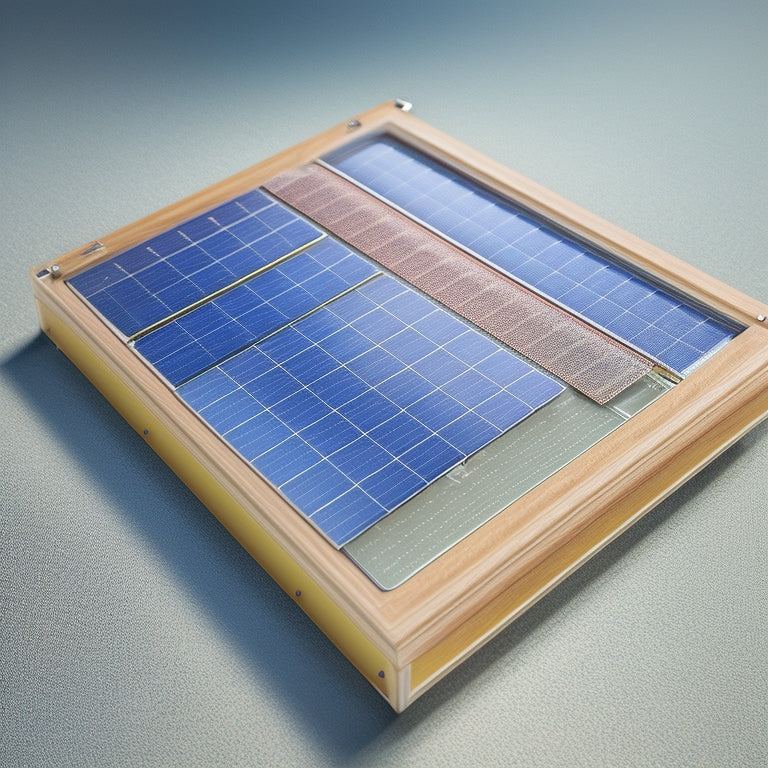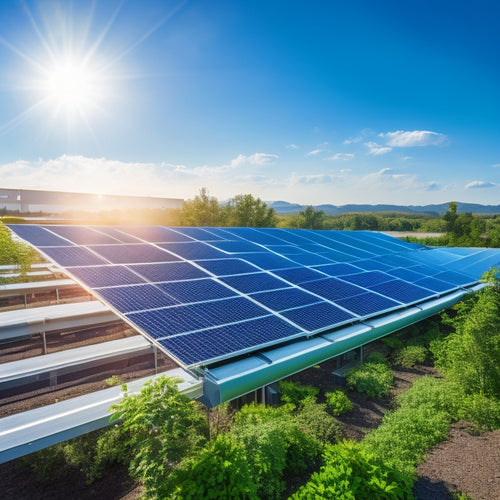
What Are Solar Panels Made of and What's Their Composition?
Share
You're about to uncover the details of solar panel composition, which plays a critical role in determining their performance, lifespan, and overall efficiency. Solar panels are made up of various components, including photovoltaic cells primarily made from silicon, which convert sunlight into electrical energy. The cells are protected by a layer of glass or plastic casing, and an anodized aluminum frame provides structural support. Electrical components and wiring optimize energy output, while the backsheet and encapsulation layer prevent corrosion and degradation. As you investigate the details of solar panel composition, you'll reveal the nuances that impact their performance and lifespan, and soon, you'll be well-equipped to make informed decisions about your renewable energy investments.
Key Takeaways
- Solar panels are composed of photovoltaic cells, typically made from semiconductor materials like silicon, which convert sunlight into electrical energy.
- The structural components of solar panels include glass, anodized aluminum frames, and thermal insulation for protection and stability.
- The backsheet and encapsulation layer, made from materials like fluoropolymers and EVA, shield the photovoltaic cells from environmental stressors.
- Electrical components and wiring, including MC4 connectors and junction box connectors, optimize energy output and facilitate connection.
- Protective coatings, applied using techniques like vacuum deposition and sputtering, shield the photovoltaic modules from UV rays, moisture, and extreme temperatures.
Solar Panel Materials Overview
When it comes to converting sunlight into electrical energy, the materials used in solar panels play an important role. You're likely aware that solar panels are a key component in utilizing renewable energy, but have you ever stopped to think about what they're made of?
As you investigate the world of solar energy, understanding the materials used in solar panels is essential.
Solar panel advancements have led to considerable improvements in efficiency and durability. Modern solar panels comprise a variety of materials, each serving a specific purpose. The most common materials used include silicon, metal frames, glass or plastic casing, and wiring.
These components work together to convert sunlight into electrical energy, making solar power a viable option for those seeking renewable energy solutions.
As you probe deeper into the world of solar energy, you'll find that the materials used can greatly impact the panel's performance and lifespan. By understanding the materials used in solar panels, you'll be better equipped to make informed decisions about your renewable energy needs.
Photovoltaic Cells Composition
You've learned that modern solar panels comprise a variety of materials, each serving a specific purpose.
Now, let's explore deeper into the photovoltaic cells composition, the heart of solar panels. Photovoltaic cells, also known as solar cells, convert sunlight into electrical energy through a process known as photovoltaics. These cells are made from semiconductor materials, typically silicon, which are carefully engineered to optimize solar efficiency.
The cell technology used in modern solar panels involves layering different materials with unique properties. The top layer is typically an anti-reflective coating, which reduces energy loss by minimizing reflected sunlight.
The next layer is the p-type silicon, which has an excess of holes (positive charge carriers). The p-type layer is followed by an n-type silicon layer, which has an excess of electrons (negative charge carriers). When sunlight hits the p-n junction, it excites the electrons, allowing them to flow through the material and create an electrical current.
The precise composition and structure of photovoltaic cells play a critical role in determining solar efficiency. By optimizing cell technology, manufacturers can increase energy output while reducing production costs, making solar energy more accessible and affordable.
Glass and Frame Structure
The glass and frame structure provides the necessary protection and support for the photovoltaic cells, ensuring their ideal performance and longevity.
As you examine the solar panel's composition, you'll notice that the glass serves as a transparent barrier, shielding the cells from environmental factors like UV rays, moisture, and debris. This protection enables the photovoltaic cells to operate efficiently, converting sunlight into electrical energy.
The frame structure, typically made of anodized aluminum, provides a sturdy foundation for the glass and photovoltaic cells. It's designed to withstand various environmental conditions, including wind, snow, and extreme temperatures.
The frame's thermal insulation properties help maintain a consistent temperature, optimizing energy production. Furthermore, the frame's aesthetic design allows for a sleek, modern appearance that complements various design styles.
Backsheet and Encapsulation Layer
A critical layer of protection lies beneath the photovoltaic cells, where the backsheets and encapsulation layers work in tandem to safeguard the delicate components within.
You'll find that the backsheets, typically made of fluoropolymers or polyesters, provide a barrier against moisture, UV radiation, and physical stress. They're also designed to be electrically insulating, guaranteeing that the photovoltaic cells operate efficiently.
The encapsulation layer, usually composed of Ethylene-Vinyl Acetate (EVA) or Polyvinyl Butyral (PVB), is applied directly to the photovoltaic cells. This layer prevents corrosion and degradation of the cells by blocking oxygen and moisture.
The encapsulation techniques used can greatly impact the overall performance and longevity of the solar panel. For instance, lamination processes can assure a strong bond between the encapsulant and the photovoltaic cells, while also minimizing defects and imperfections.
Electrical Components and Wiring
You'll find that a solar panel's electrical components and wiring are carefully designed to optimize energy output.
When examining a panel's wiring diagram, you'll identify electrical connection points that facilitate the flow of energy.
These connection points are critical, as they enable the panel to convert sunlight into usable electricity.
Panel Wiring Diagrams
Diagramming the electrical components and wiring of a solar panel is crucial to guarantee efficient energy utilization and safe operation. You'll need to understand the wiring types and diagram symbols to create an accurate representation of your panel's electrical layout.
There are two primary wiring types: series and parallel connections. Series connections link modules in a sequential manner, increasing voltage while maintaining current. Parallel connections, on the other hand, link modules in a side-by-side configuration, increasing current while maintaining voltage.
When creating a wiring diagram, you'll use standardized symbols to represent components. These symbols include rectangles for solar panels, circles for diodes, and lines for wires. You'll also use arrows to indicate the direction of current flow.
Accurate diagramming guarantees that you can identify potential issues, troubleshoot problems, and perform maintenance tasks efficiently. A well-designed wiring diagram is crucial for maximizing your solar panel's energy output and guaranteeing a safe operating environment.
Electrical Connection Points
Creating an accurate wiring diagram relies on identifying and understanding the electrical connection points within your solar panel system. These connection points are essential for ensuring the safe and efficient transmission of electrical energy from your solar panels to your inverter, charge controller, or other system components.
When examining your solar panel's electrical connection points, you'll encounter various connection types, including:
| Connection Type | Description | Location |
|---|---|---|
| MC4 Connectors | Industry-standard connectors for solar panels | On the back of the panel |
| Junction Box Connectors | Connectors within the junction box for module interconnection | Inside the junction box |
| DC Connectors | Connectors for DC cabling between the solar panel and inverter/charge controller | Between the panel and inverter/charge controller |
Understanding these connection types and their locations is fundamental for designing a reliable and efficient solar panel system. The junction box, in particular, plays a critical role in housing the electrical connections between modules, making it a significant component of your solar panel's electrical connection points. By recognizing and understanding these connection points, you'll be better equipped to design and install a safe and efficient solar panel system.
Aluminum Frame and Mounting
The aluminum frame provides structural support to the solar panel, serving as a backbone that holds the photovoltaic modules in place. You'll find that it's typically made from anodized aluminum, which enhances its corrosion resistance and durability.
This frame durability is essential, as it guarantees the panel can withstand various environmental conditions, including extreme temperatures, wind, and snow.
When it comes to mounting options, you have several choices. You can opt for a fixed-tilt mounting system, which is ideal for installations with limited space. Alternatively, you can choose a tracking system, which allows the panel to follow the sun's movement, maximizing energy output.
You may also consider roof-mounted or ground-mounted options, depending on your specific installation requirements. Regardless of the mounting option you choose, the aluminum frame provides a sturdy base that assures the solar panel's stability and performance.
Its corrosion-resistant properties guarantee that it remains functional even in harsh environments, providing you with reliable power generation over an extended period.
Protective Coatings and Finishing
Most solar panels feature a protective coating that shields the photovoltaic modules from environmental elements, ensuring ideal energy output. This coating is essential as it prevents damage from UV rays, moisture, and extreme temperatures, which can compromise the panel's performance.
You'll find that the coating's durability is a vital factor in determining the panel's overall lifespan.
The finishing techniques used to apply this coating are just as important. Manufacturers employ various methods, such as vacuum deposition, sputtering, or spray coating, to achieve a uniform and defect-free layer. The choice of technique depends on the type of coating material and the desired level of protection.
For instance, some coatings may require a specific thickness or texture to maximize their effectiveness.
When selecting a solar panel, you should consider the type of protective coating used and its durability. A high-quality coating can greatly impact the panel's energy output and overall performance.
Look for panels with coatings that have been tested and certified to withstand harsh environmental conditions, ensuring you get the most out of your solar investment.
Frequently Asked Questions
How Do Solar Panels Perform in Extreme Weather Conditions?
When you install solar panels, you'll find they perform relatively well in extreme weather conditions, with temperature effects impacting performance efficiency; however, you'll notice a slight drop in efficiency during intense heat or cold, but they'll still generate power.
Can Solar Panels Be Recycled at the End of Their Life?
You'll be glad to know that, yes, solar panels can be recycled at the end of their life, with solar panel recycling facilities reclaiming precious materials like silicon, glass, and metals, minimizing end of life disposal waste and environmental impact.
Are Solar Panels Resistant to Hail and Other Impacts?
You're about to release a storm of clean energy, but first, you wonder if your solar panels can weather the storm - literally. Thankfully, they're built to withstand impact resistance, minimizing hail damage, and ensuring your power stays on even when the sky turns dark.
How Often Should Solar Panels Be Cleaned and Maintained?
You should clean your solar panels every 6-12 months, depending on climate and debris, to guarantee peak energy production; follow maintenance tips like avoiding abrasive materials, using deionized water, and inspecting for damage to maximize your power output.
Can Solar Panels Be Used to Generate Electricity at Night?
You might think solar panels are useless at night, but you're wrong - they can generate electricity 24/7 with energy storage systems, like batteries, which optimize solar panel efficiency, ensuring a steady power supply even in darkness.
Conclusion
Now that you've examined the composition of solar panels, you're likely wondering how these complex components come together to generate clean energy. Visualize a photovoltaic cell as the heart of the panel, sandwiched between protective layers and connected by electrical wiring. The aluminum frame provides structural integrity, while the backsheet and encapsulation layer shield the panel from environmental stressors. With each component working in harmony, solar panels efficiently convert sunlight into electricity, making them an essential solution for a sustainable future.
Related Posts
-

Sustainable Home Design for Reduced Carbon Footprint
Sustainable home design is your pathway to a smaller carbon footprint and a healthier living space. By incorporating ...
-

Solar Energy Efficiency Improvements for Businesses
Improving solar energy efficiency for your business can lead to considerable cost savings and enhance your sustainabi...
-

Green Energy Alternatives for Independent Living
To enhance your independent living, consider green energy alternatives like solar panels and wind turbines. These opt...


